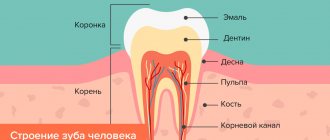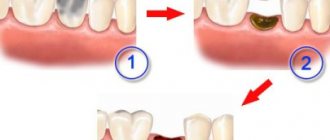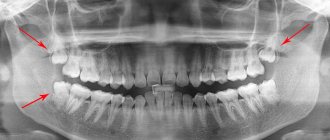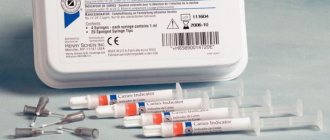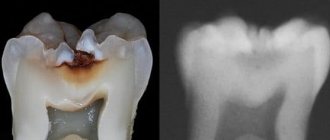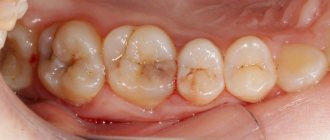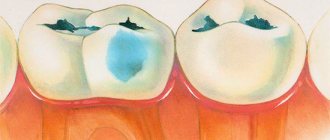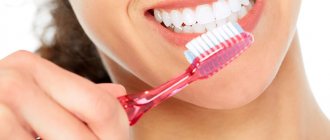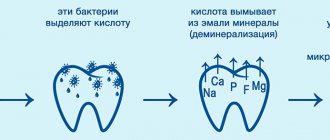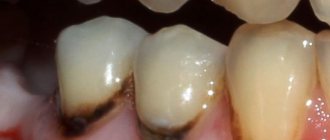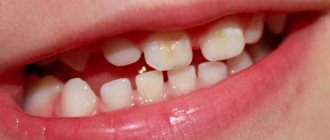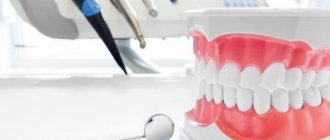Science knows that caries develops due to bacteria that are found in plaque. Almost all types of germs can be transmitted from one person to another. In this regard, the question arises whether caries is contagious. This can be answered in the affirmative. However, everything is much more complicated than it seems.
In this article
- The problem of caries development
- Is tooth decay contagious?
- Why is tooth decay contagious in children?
- Is caries inherited?
- Does caries transfer from one tooth to another?
There are many myths surrounding caries, as one of the most common dental diseases. Most people believe that carious lesions are a consequence of poor hygiene. Some people believe that caries is transmitted through saliva, so you can get it during a kiss. Scientists claim that the main cause of this pathology is cariogenic microbes from the Streptococcus group. Moreover, each of these statements is partially or completely true. Let's try to figure out whether caries is transmitted from person to person or not. First, let's find out what causes this disease.
The problem of caries development
Caries is the slow process of destruction of enamel and dentin - the hard tissues of the tooth. It is caused by harmful bacteria of the Streptococcus mutans group.
These microbes live off the carbohydrates that a person eats and multiply in the oral cavity if he does not follow the rules of hygiene. At the same time, they release acid, which eats away the enamel and destroys dentin. This is the main cause of tooth decay. There are a number of factors predisposing to this disease:
- Insufficient hygiene. If a person does not brush his teeth or does it rarely and incorrectly, the risk of developing caries increases many times over. Bacteria and their metabolic products are washed off with a toothbrush and toothpaste. Lack of hygiene leads to the rapid spread of germs in the oral cavity.
- Poor nutrition. Streptococcus mutans feed mainly on sucrose, so carious lesions are observed more often in people who abuse sweets.
- Bad habits. Smoking contributes to the formation of plaque and tartar on teeth, which are a favorable environment for cariogenic microbes.
- Weak immunity. The body can resist germs if it has good protection in the form of a strong immune system. Otherwise, a person becomes more vulnerable to any diseases, including caries.
- Taking certain medications. They can cause problems with metabolism or saliva production. It contains substances that neutralize acids left behind by bacteria. In addition, due to insufficient secretion, microbes are not washed away from the oral cavity.
- Hormonal imbalances. Impaired hormone production causes metabolic problems, which causes weakening of the enamel.
- Lack of vitamins and minerals. If the body receives little magnesium, fluorine, phosphorus, and calcium, tooth enamel becomes more vulnerable to cariogenic microbes.
There are other causes of caries, for example, childhood, pregnancy, wearing orthopedic structures, etc. As a rule, carious lesions occur as a result of the influence of not just one factor on the body, but a whole group.
Infecting children with caries through a parental kiss
Parents transmit bacteria to children through kissing
Newborns do not have pathogenic microorganisms in their mouths that can cause caries, just as there are no teeth on which they would parasitize. But sooner or later the first teeth erupt and pathogenic bacteria are transmitted along with parental caresses.
Important. The most dangerous infection is for children under three years of age, since their immune system is not yet fully developed.
Below are the reasons that in older children neutralize the penetration of streptococcus mutans and other caries-forming pathogens into the mouth:
- rough food mechanically removes old plaque from the enamel;
- girls and boys over 3 years old (in most cases) are accustomed to oral hygiene;
- a stable buffer capacity of saliva is formed, i.e. it can neutralize acidic elements;
- a more resilient immune system.
The note. The later the mouth infection occurs, the better it will be for the health of baby teeth.
But it’s not only through a parent’s kiss that a baby can be infected; for example, mothers often lick nipples, spoons, slobber on handkerchiefs and wipe their mouths with them, and so on. Some parents, on the contrary, go to extremes: they wipe everything with alcohol, boil it, and so on. To guide mothers on how to maintain normal hygiene (table), watch the video in this article.
Table. How to avoid infecting your child with caries:
| Measure | A comment |
| Before feeding, it is not advisable to taste food (for salt, temperature, etc.) with the same spoon that the child will eat with. Ideally, the child should have his own dishes. |
| When dropped, a pacifier or any other object should be washed rather than licked. |
| There is no need to slobber on the cloth to wipe your baby's lips; for this purpose it is better to have baby wipes with you. |
| Each family member should have their own oral hygiene equipment. They need to be cleaned and replaced at least every two to three months. |
Sooner or later, infection will still occur, but this does not mean the development of caries, since for this there must be many additional factors.
Is tooth decay contagious?
Since caries is a direct consequence of exposure to microbes on teeth, the question of the contagiousness of this disease is fair. However, these microorganisms are not as highly contagious as influenza, ARVI, tuberculosis and other viruses and bacteria to be transmitted by airborne droplets. Moreover, these microbes, being part of our microflora, are found in the oral cavity of all older people, except newborns.
But it is worth understanding that their presence does not always lead to the development of caries. There must be the predisposing factors discussed earlier. Some people never get tooth decay, while others cannot get rid of it for years. At the same time, cariogenic microbes are found in the oral cavity of both. Only with weak immunity, poor hygiene and the presence of other factors, the microbes that cause caries become dangerous.
Thus, it is impossible to become infected with caries through a kiss, someone else’s spoon, fork, toothbrush and other personal items. However, there is a category of people for whom cariogenic microbes from the oral cavity of another person are dangerous. We are talking about small children.
Beneficial and harmful microorganisms
In addition to the above substances, microorganisms participate in the metabolism, both beneficial: bifidobacteria or lactobacilli, and harmful, for example, Streptococcus mutans. The latter bacteria play an important role in the occurrence of caries. Microorganisms have an individual composition for each person. When they are transmitted, cross-immunization occurs - foreign bacteria contribute to the production of antibodies, which makes the immune system work.
But weak immunity is not a death sentence. If you regularly perform certain actions, you can kiss as much as you like without causing consequences, such as discomfort in the mouth, aching or sharp pain, or loss of teeth. Read about the rules of dental care in the article “Measures for preventing caries.”
We invite you to familiarize yourself with the process of installing implants - a description of the procedure.
Why is tooth decay contagious in children?
They are more susceptible to tooth decay than adults. There is an explanation for this: children eat more sweets, take care of their hygiene worse, and have a weaker immune system. If there are cariogenic microbes in the oral cavity, the risk of developing caries in a child is higher than in an adult. This especially applies to very young children under the age of 3 years.
Let us describe several typical cases that can lead to infection of a child with bacteria of the Streptococcus group. So, a baby can become infected with tooth decay when the mother tries his food to check her temperature. This cannot be done, and not only because of cariogenic microbes. An adult’s mouth contains many bacteria that a child’s immune system cannot cope with. There is a risk of infection with microbes that will cause an infection. Some mothers, if their baby drops the pacifier, suck on it and put it back in the baby's mouth. In such situations, women risk both their health and the health of their children.
Caries in baby teeth develops quickly, destroying hard tissue and damaging the gums. The baby constantly cries and refuses to eat. Many parents turn a blind eye to this problem, believing that caries of primary teeth is not dangerous. However, it can cause complications, including: oral infections, systemic diseases, gastrointestinal problems and caries of molars.
Precautionary measures
Preventive measures play a huge role in preventing the development of caries. They are aimed mainly at preventing the active development of carious bacteria.
These measures include:
- regular brushing of teeth with an antiseptic paste,
- the use of dental floss (floss) and other means to maintain oral hygiene,
- rinsing with antibacterial solutions, balms,
- chewing sugar-free gum for 10 minutes after eating (do not stay longer; chewing gum changes from being a collector of microbes to spreading them over time),
- ensuring yourself a balanced diet, including dairy products, raw vegetables and fruits,
- diligently chewing food, especially hard food (this helps cleanse tooth enamel from plaque and improve the body’s absorption of microelements from food),
- moderate consumption of sweets, cakes, baked goods made from white flour, sweet soda,
- annual preventive examinations at the dentist,
- Do not delay visits to the doctor if any problems appear in the oral cavity.
Neglecting these recommendations is fraught with the appearance of carious holes in the teeth, pain and expensive treatment. Therefore, they should be treated responsibly. It is important to teach proper oral care to children from an early age. Do you feel nervous before visiting the dentist?YesNo
Is caries inherited?
This is another common question related to the nature of the origin of caries. Incorrect metabolism, weak immunity, abrasion of enamel and anatomical structures of the jaw can be inherited from parents to children. Oral bacteria do not pass from mother to child during pregnancy or delivery. A child may have a genetic predisposition to diseases and conditions that increase the risk of developing tooth decay. There is no gene for caries pathology as such.
Can caries be transmitted through a kiss and is it possible to become infected with it?
It is widely known that the main factors in the development of caries include poor oral hygiene, as well as a lack of calcium, phosphorus and fluorine in the body, which are the main building elements of hard dental tissues.
However, there is also an opinion that tooth decay is transmitted through a kiss and can literally be contracted from another person. Is this really true, is caries contagious or is it a myth - let's try to understand these issues in more detail...
Let's start with the fact that the root causes of carious changes are indeed directly related to the biochemical processes occurring under dental plaque and in its volume due to the activity of microorganisms. The presence of a huge number of bacteria in dental plaque leads to active fermentation of carbohydrates (for example, sugar), which turn into organic acids. Under the influence of acids, the pH on the surface of tooth enamel decreases and demineralization occurs - in other words, calcium and phosphorus are washed out of the tooth enamel.
As a result, we come to the preliminary conclusion that caries is indeed directly related to the activity of bacteria. And if so, then a logical question arises: is caries contagious and can it be transmitted through a kiss?
Does caries transfer from one tooth to another?
Can a tooth affected by caries lead to infection of the tissue of neighboring teeth with carious bacteria? This happens in the absence of treatment and insufficient hygiene. The number of bacteria in the mouth increases, they spread throughout the entire cavity, forming pathological foci in different places of the jaw. The patient may be diagnosed with multiple caries with localization of carious lesions on several teeth.
So, it is possible to become infected with caries, but carious bacteria alone are not enough for the development of the disease. Only in the presence of several factors does a person begin the process of demineralization of enamel and destruction of dentin. Dentists recommend not to worry about this and not be afraid of contracting caries through a kiss. It is better to pay more attention to hygiene. However, brushing your teeth alone is not enough. As additional hygiene products, it is necessary to use dental floss, rinses and irrigators. Doctors also advise eating right, exercising, and visiting the dentist twice a year. If you follow preventive measures, you can live your whole life without caries.
Sources:
- tvoidantist.ru
- stoma.click
- mnogozubov-ru.turbopages.org
Infection in adults
Teeth affected by caries
It is not true to believe that tooth decay is transmitted through a kiss. It is caused by bacteria under certain factors (listed below).
But it is important to understand that every adult already has a full set of these same bacteria, so you can kiss calmly and not be afraid that this will certainly cause caries. If there is no caries, this means that a person has strong protective mechanisms and genetically determined factors that prevent the formation of pathogenesis. A significant part in this is due to hygiene and human lifestyle.
The following factors contribute to the development of caries:
- weak immunity;
- poor-quality and unbalanced nutrition: deficiency of microelements and vitamins, excessive passion for sweets, carbonated drinks such as forfeit or cola;
- poor oral hygiene, the use of toothpaste and toothbrushes, the price of which is the lowest, so a person thinks that his teeth are safe after two brushings, but this is not entirely true, since hard-to-reach places remain uncleaned;
- the presence of bad habits, for example, older women who smoke are much more likely to visit dentists and lose teeth than men of the same age;
- prolonged drug therapy, self-medication, which leads to disruption of the integrity of enamel and dentin;
- endocrine pathologies;
- wearing orthopedic or orthodontic structures, which, firstly, cause damage to the tooth, and secondly, make it difficult to clean the teeth.
The myth that caries is transmitted to another tooth – Ask the dentist!
Can caries move from one tooth to another?
Can caries be transmitted from one tooth to another?
In principle, this is possible. After all, caries is caused by microorganisms, microbes, and they can also affect neighboring teeth. But it would still be more correct in this case to say not that the caries was transferred to another tooth, but that the person brought another tooth to caries.
Because caries microbes always exist in the oral cavity, even healthy people have them, but these people and their teeth do not suffer from caries. Because in addition to the presence of microbes, for caries to occur, you need to stop caring for your teeth.
Leave them under plaque and food debris, because it is in secluded places that microbes are not neutralized by saliva and can begin to develop, causing caries. After all, caries is not the eating of a tooth by microbes, but its destruction by the acid that microbes secrete.
Myths about caries: is it only a childhood disease that is inherited?
There are many myths about tooth decay. Which of them have a basis, and which
Caries is inherited
Generally untrue, but there is some truth in it. Of course, caries is not a hereditary disease. However, tooth enamel is formed while a person is still in the womb. Infectious diseases suffered during pregnancy, mineral metabolism disorders, toxicosis and premature birth can lead to weak or underdeveloped tooth enamel.
To prevent such problems, the expectant mother should include dairy products and fish in her diet. They contain calcium and phosphorus, two key elements for the formation of healthy tooth enamel.
The development of caries is also influenced by the type of fissures - natural curves on the surface of the tooth. Their structure is also given to us from birth. The more irregularities, pits, and grooves, the more places for plaque to accumulate and bacteria to multiply.
You can get infected with tooth decay
Is it true. Caries is caused by bacteria - Streptococcus mutans, or mutating streptococcus. These are the “carious monsters” we know from advertising. Their habitat and reproduction is dental plaque.
When processing leftover food, they release organic acids. Because of them, tooth enamel loses minerals, and hard tooth tissues begin to dissolve.
It is very difficult to destroy this type of streptococcus because the bacteria mutate quickly.
Unfortunately, a healthy person can become infected with caries through everyday life - through shared utensils or by kissing on the lips. “Holes in the tooth” are often passed from mother to child if she tries food and feeds the baby with the same spoon.
The best way to keep your loved ones safe is to use separate utensils and wash them very carefully.
Children are most susceptible to dental caries
It's a delusion. Children, of course, are more susceptible to pathogenic bacteria than adults, but older people are more susceptible to caries, especially root caries. With age, the gum muscles weaken and the edges of the gums “retreat” from the tooth. A gap appears, and it is easier for bacteria to penetrate directly to the root.
In addition, the chemical composition of saliva and its quantity play an important role in the natural protection of our teeth from caries. Saliva has antibacterial properties and can neutralize acids that destroy teeth.
It flushes out food debris from the mouth and supplies the teeth with essential minerals. With age, the composition of saliva changes, dry mouth appears, indicating a decrease in the activity of the salivary glands.
Teeth are washed less well, and carious processes are more active.
Proper brushing of teeth is the best protection against caries
This is true. The goal of daily brushing is not just to freshen your breath, but to cleanse your mouth as much as possible of plaque and food debris, so that bacteria simply have nowhere to multiply.
You need to brush your teeth after breakfast and before bed, for at least three minutes. If you don't feel like timing yourself, just do it while listening to music. The average song lasts just about three minutes.
Advertising has taught us to squeeze out a thick layer of paste over the entire surface of the bristles. In fact, to clean your teeth well, a pea-sized amount of toothpaste is enough.
We usually rinse our mouth with water after brushing. This is not entirely correct. Water washes away the active substances contained in the toothpaste and reduces protection.
It is better to use alcohol-free rinses - they soften and remove plaque and are able to finish the job of cleaning the tooth behind the brush.
Dentists insist that evening cleaning should be especially thorough. During sleep, the activity of the salivary glands sharply decreases, which means that the teeth are less protected than during the day.
Before going to bed, it is advisable to use not only toothpaste and mouthwash, but also dental floss, “walking” through all the spaces between the teeth.
Six myths about caries and dental health.
The most common disease in the world is dental caries. Nine out of ten people know about this disease firsthand. Naturally, there are many myths and misconceptions floating around such a popular disease. Myths about caries are debunked by Irina Marykova, general director of the dental clinic “Dentalia”.
Myth one. Tooth decay occurs if you eat a lot of sweets
Recent studies of the role of carbohydrates in the occurrence of caries have found that it all depends on the time they remain in the mouth after eating. Small particles of food remain between the teeth, in the folds of the mucous membrane and on the tongue.
Sugar, sweet drinks, chocolate and some confectionery products are quickly dissolved by saliva and washed away, but complex carbohydrates found in baked goods, meat products or fruits take longer, so their breakdown begins right in the mouth.
It involves not only salivary enzymes, but also microorganisms. The food breakdown products they secrete are one of the factors in the occurrence of caries.
Myth two. Caries are holes in the teeth
Most patients go to the dentist only when they notice a hole in their tooth or when severe toothache occurs. In fact, the first signs of caries become visible long before holes appear. Areas appear on the teeth that lose their shine, become lighter, and sometimes even appear loose.
This is already caries. At this stage, you can do without a drill using conservative methods. If at this stage the dentist has not seen your teeth, the process worsens and a depression appears in the tooth enamel. It doesn’t hurt yet, but discomfort appears when eating hot, cold or sour food.
A filling is already needed here.
Pain occurs already with medium and deep caries; it is at this stage that a person runs to the doctor. And the doctor puts complex fillings on him. And if the patient had gone to the doctor when there was no pain yet, perhaps all the teeth would have remained intact. That's why dentists recommend undergoing a preventive examination twice a year, even when your teeth are not bothering you.
Myth three. There is no need to treat baby teeth - they will fall out anyway
Wrong. You should definitely contact a pediatric dentist. Baby teeth fall out as a result of physiological resorption of their roots. Between them all this time there are permanent teeth, which erupt in place of milk teeth.
If left untreated, caries of a baby tooth can lead to inflammation, delayed eruption, underdevelopment of enamel, or even complete melting of the permanent tooth germ.
Myth four. Sick or healthy teeth is a hereditary issue. If your teeth are good, you don’t have to take care of them, but if you have bad teeth, no matter how hard you try, there will be caries
It is a myth. Heredity plays some role in the condition of teeth. But caries depends little on heredity. Simple preventive measures can help prevent tooth decay, whether mom had good teeth or not. By the way, 90% of the population suffers from caries in our country. And we have practically no people with completely healthy teeth.
Myth fifth. It is not worth treating a diseased tooth “to the last”, it is better to remove it
No. Removing a tooth will cause adjacent teeth to gradually shift, which will affect your appearance and can create serious chewing problems. Displacement will necessarily occur, because each of the teeth in the dental system has its own function and load. Therefore, it is better to treat the tooth “to the last.” But if removal cannot be avoided, it is better to immediately place an implant.
Myth six. Healthy enamel - white enamel
No. There are no absolutely white teeth in nature. Their color depends on dentin and is inherited. It is believed that the strongest tooth tissues are those whose color is yellowish.
Alexander Nekipelov, director of the dental “Beautiful Smile Clinic”:
— You need to visit the dentist twice a year, even if nothing bothers you, for a very simple reason.
To keep your teeth healthy, it is important to “catch” caries before it has yet developed, in the so-called “white spot” stage. This is noticeable even to the naked eye.
All tooth tissue is the same color, but there are white spots on it. With timely treatment, caries can be stopped at this stage and will not develop further.
Regular visits to the dentist can also protect you from developing such an unpleasant disease as periodontitis. The first “bell” indicating the possibility of developing this disease is if blood appears while brushing your teeth. The second is when a so-called stone appears on the teeth.
You probably saw scale inside the kettle. This is what tartar looks like. If you properly and professionally observe oral hygiene, remove plaque and tartar in a timely manner, then periodontitis will not develop.
And if you arrive at the stage when the teeth have already become mobile, this means a long and complex treatment.
In addition, if a person has dentures or crowns, they also need regular examinations and preventive maintenance.
Myth two. Caries are holes in the teeth Dentistry-portal. ru Read more…
10.07.2019 20:41:47
Source: https://BeautySmile.su/voprosotvet/2019/07/22/mif-chto-karies-peredaetsya-na-drugoj-zub/
What to do if a patient’s saliva gets on the skin or mucous membranes
The danger of infection through saliva exists when there is damage to the surface of the skin or mucous membranes - scratches, cuts, cracks. In rare cases, when a person infected with hepatitis has a high viral load, he suffers from bleeding gums, and his saliva accidentally comes into contact with another person's damaged tissue, causing infection.
What to do in a dangerous situation to avoid infection:
- if damaged skin comes into contact with infected saliva, squeeze out a small amount of blood from the wound, then treat with a soap solution, apply alcohol or iodine;
- saliva that gets into the eye should be removed with a large amount of water, followed by rinsing with a solution of boric acid at a concentration of 1%;
- if saliva gets on the oral mucosa, if there is damage on it, you need to spit and rinse your mouth several times with a solution of potassium permanganate;
- contact of infected saliva with the nasal mucosa requires the use of a disinfectant, for example, Protargol drops - they contain silver proteinate, which destroys pathogenic flora and prevents infection.
To prevent secondary infections from entering the skin wound, it is recommended to cover it with a sterile bandage or apply an antiseptic bandage. A solution of brilliant green is considered a simple but effective antiseptic - it is used to smear the open wound several times a day until complete healing.
Transmission of the hepatitis virus to a healthy person through the saliva of a patient is unlikely, but not impossible. To avoid infecting others, an infected patient must monitor the integrity of the oral mucosa and promptly cure bacterial diseases of the throat and gum pathologies. It is forbidden to share hygiene items with the patient, on which particles of his blood could remain.
Dental caries: tips and reviews
Dental health rests on three pillars: proper care, proper nutrition and regular examination. Therefore, the advice in the fight against tooth decay is to stick to these simple basics of healthy teeth.
Svetlana. Unfortunately, I neglected my teeth and went to the dentist when the caries had already reached the middle stage. Used laser treatment. It's really painless. But, really, it’s burdensome for the wallet. Now I will periodically go for preventive examinations. It's more economical.
Lyudmila. It is better to prevent caries. Treatment is more expensive than periodic examinations and identifying the problem at an early stage.
Age restrictions
The immune system can protect against carious lesions as early as three to four years of age. By this age, the composition and volume of saliva are normalized, which can also protect against caries. On top of that, by the age of three, a child already knows how to independently monitor the condition of his teeth: brush them regularly, chew solid food, which effectively removes plaque.
Caries on teeth
Therefore, caries is transmitted to a child through a kiss only until he is three or four years old, until his internal protection and good habits are formed. No matter how much you want to kiss your baby every minute, you first need to take care of the condition of your teeth. Otherwise, you may encounter negative consequences for the child, which we wrote about in the article “Causes and treatment of bottle caries.”
We hope that our article helped you find answers to your burning questions. You can leave your feedback in the comments.
If you liked the article, please like it and share it with your friends.
We suggest you familiarize yourself with Caries of baby teeth: where does it come from and how to cure it
Tags:Dental diseases, Caries
